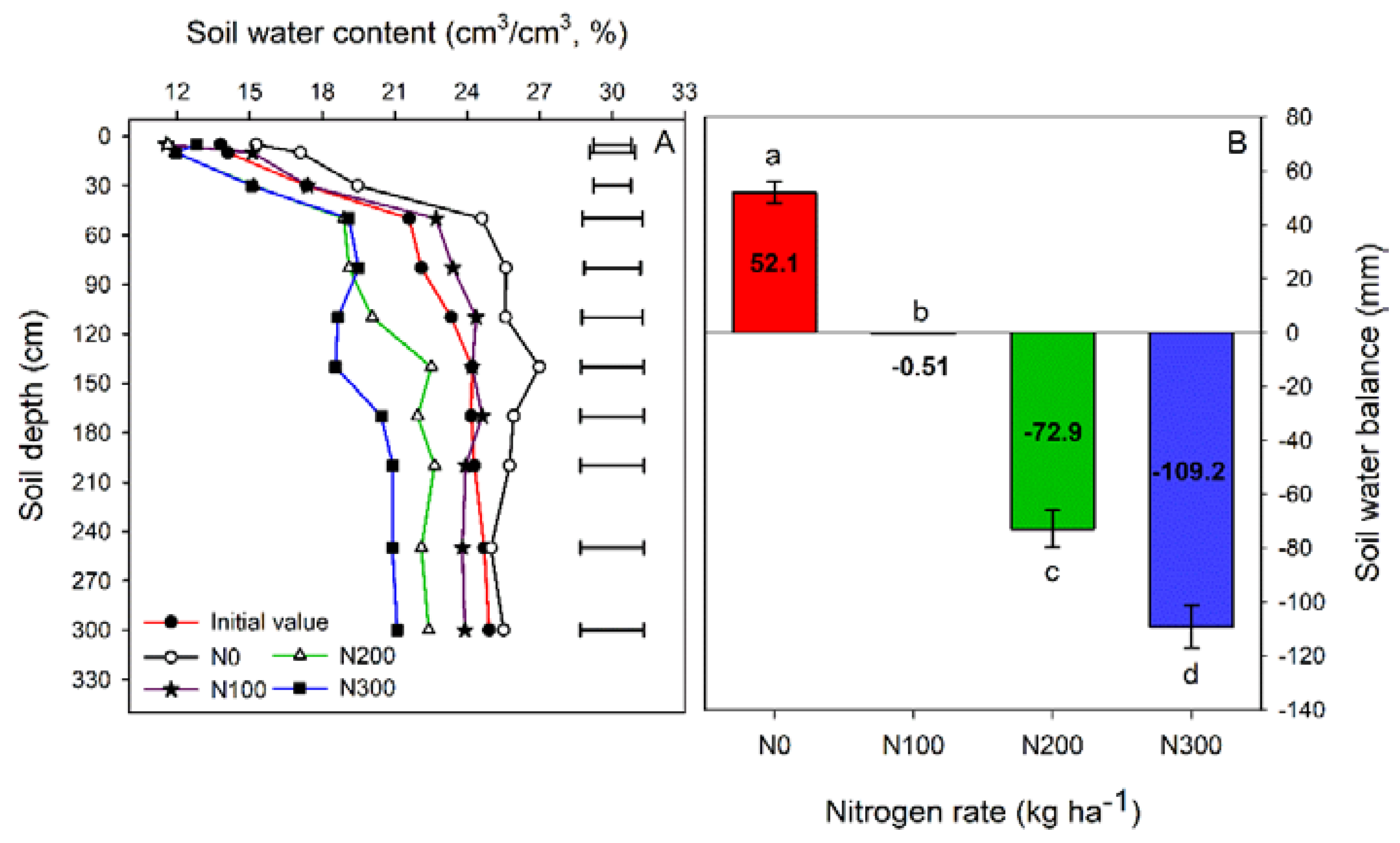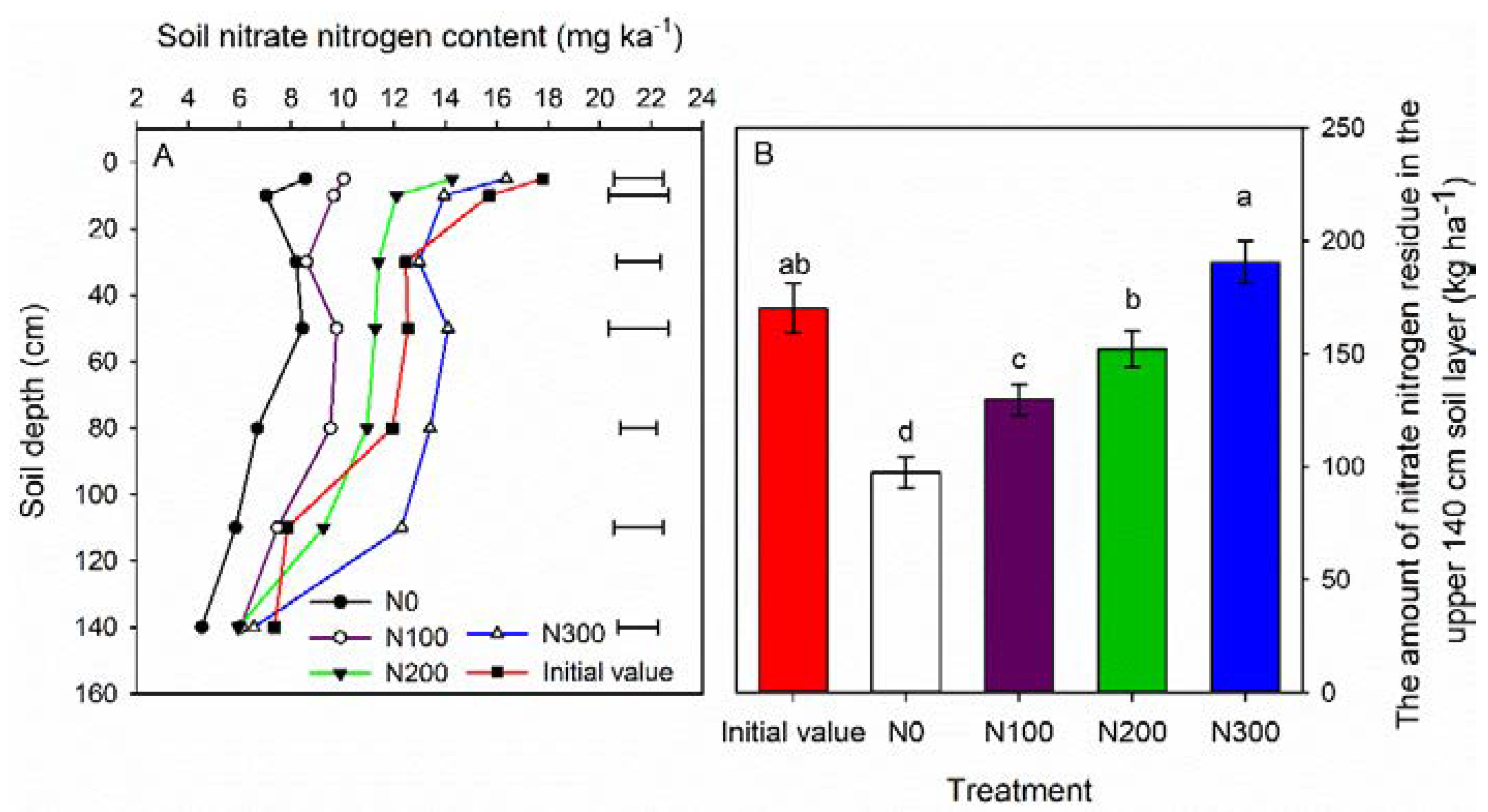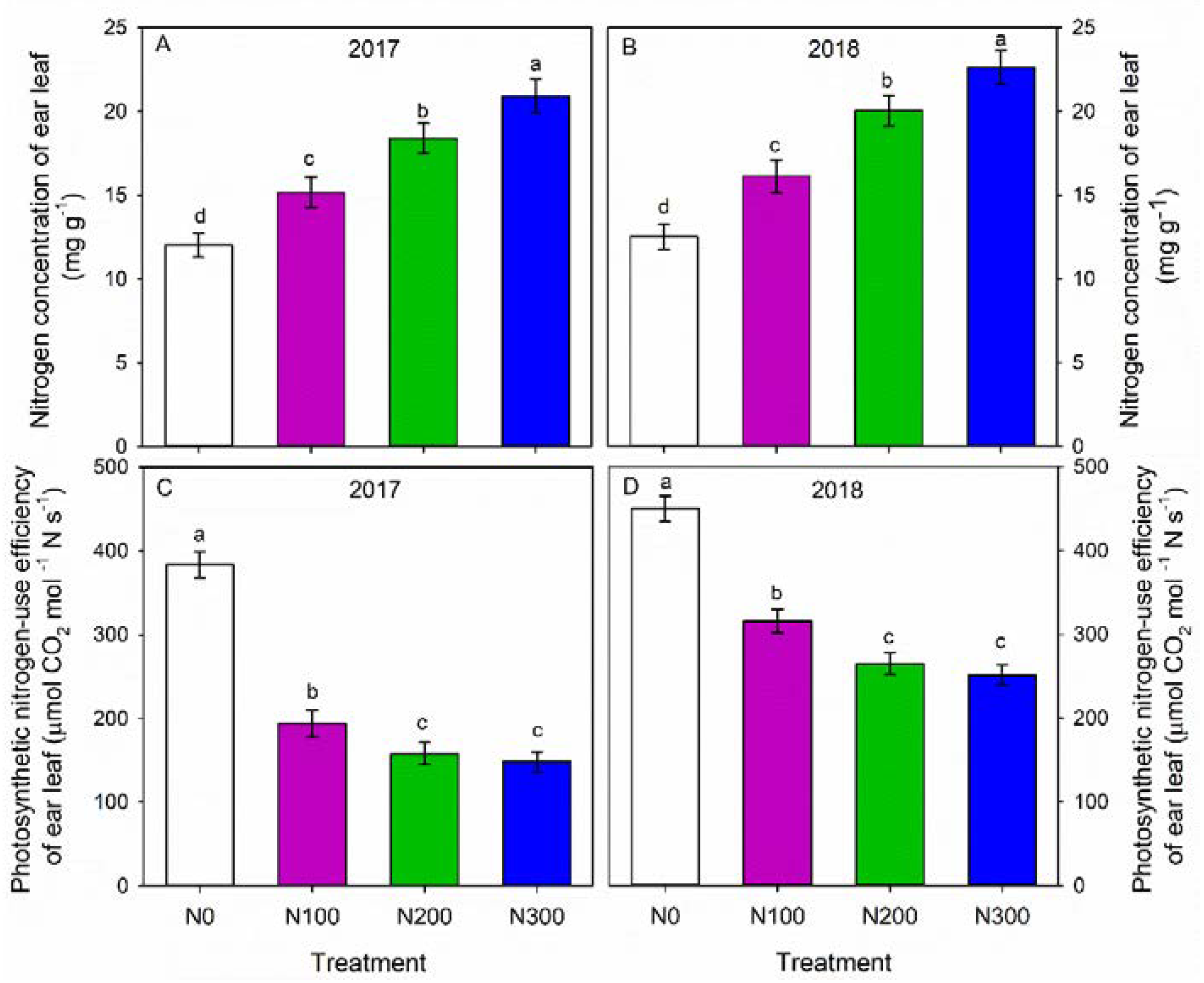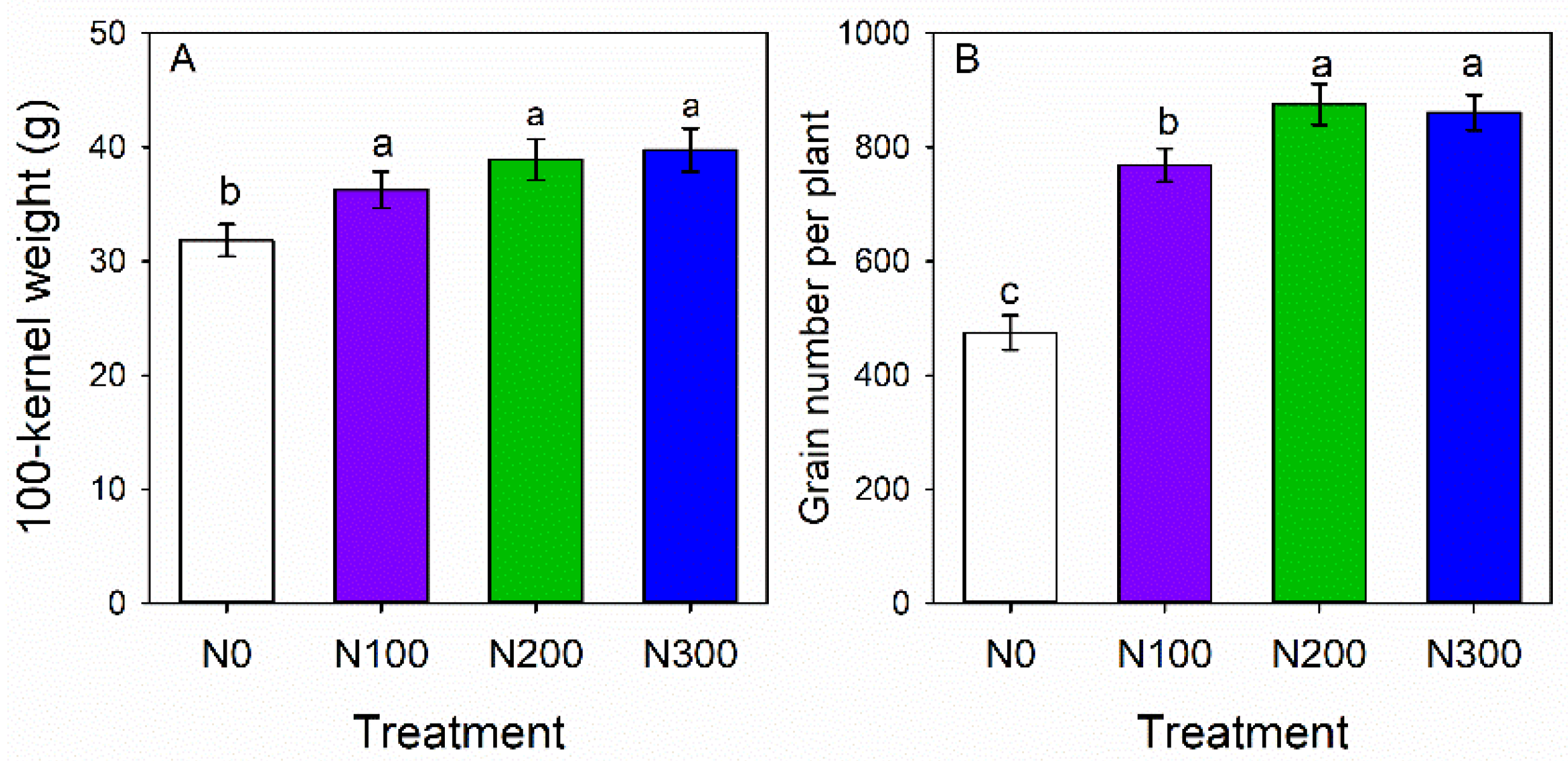Optimal Nitrogen Rate Increases Water and Nitrogen Use Efficiencies of Maize under Fully Mulched Ridge–Furrow System on the Loess Plateau
Abstract
1. Introduction
2. Materials and Methods
2.1. Site Description
2.2. Experimental Design
2.3. Sampling and Measurements
2.3.1. Precipitation and Drought Index
2.3.2. Soil Water Content
2.3.3. Soil Nitrate Nitrogen Measurement
2.3.4. Leaf Area Index and Photosynthetic Measurements
2.3.5. Yield
2.3.6. Water and Nitrogen Use Efficiency, Economic Return
2.4. Data Analysis
3. Results
3.1. Weather Condition
3.2. Soil Water Balance
3.3. Soil Nitrate Nitrogen Residue
3.4. Leaf Area Index, Net Photosynthetic Rate, and Water Use Efficiency at the Leaf Level
3.5. Nitrogen Uptake Leaf Nitrogen Concentration, NHI, REN, and PNUE
3.6. Biomass Accumulation and Grain Yield
3.7. Evapotranspiration and Water Use Efficiency
3.8. Agronomic Use Efficiency of N Fertilizer and Economic Return
4. Discussion
5. Conclusions
Author Contributions
Funding
Institutional Review Board Statement
Informed Consent Statement
Data Availability Statement
Conflicts of Interest
References
- Deng, X.P.; Shan, L.; Zhang, H.; Turner, N.C. Improving agricultural water use efficiency in arid and semiarid areas of China. Agric. Water Manag. 2006, 80, 23–40. [Google Scholar] [CrossRef]
- Huang, G.; Chen, W.; Li, F. Rainfed Farming Systems in the Loess Plateau of China. In Rainfed Farming Systems; Tow, P., Cooper, I., Partridge, I., Birch, C., Eds.; Springer: Dordrecht, The Netherlands, 2011; pp. 643–669. [Google Scholar]
- Yang, X.Y.; Li, P.R.; Zhang, S.L.; Sun, B.H.; Chen, X.P. Long-term-fertilization effects on soil organic carbon, physical properties, and wheat yield of a loess soil. J. Plant Nutr. Soil Sc. 2011, 174, 775–784. [Google Scholar] [CrossRef]
- Li, F.M.; Li, X.G.; Javaid, M.M.; Ashraf, M.; Zhang, F. Ridge-furrow plastic film mulching farming for sustainable dryland agriculture on the Chinese loess plateau. Agron. J. 2020, 112, 3284–3294. [Google Scholar] [CrossRef]
- Peng, Z.; Wang, L.; Xie, J.; Li, L.; Coulter, J.A.; Zhang, R.; Luo, Z.; Cai, L.; Carberry, P.; Whitbread, A. Conservation tillage increases yield and precipitation use efficiency of wheat on the semi-arid Loess Plateau of China. Agric. Water Manag. 2020, 231, 106024. [Google Scholar] [CrossRef]
- Peng, Z.L.; Wang, L.L.; Xie, J.H.; Li, L.L.; Coulter, J.A.; Zhang, R.Z.; Luo, Z.Z.; Kholova, J.; Choudhary, S. Conservation tillage increases water use efficiency of spring wheat by optimizing water transfer in a semi-arid environment. Agronomy 2019, 9, 583. [Google Scholar] [CrossRef]
- Wang, L.L.; Xie, J.H.; Luo, Z.Z.; Niu, Y.N.; Coulter, J.A.; Zhang, R.Z.; Li, L.L. Forage yield, water use efficiency, and soil fertility response to alfalfa growing age in the semiarid Loess Plateau of China. Agric. Water Manag. 2021, 243, 106415. [Google Scholar] [CrossRef]
- Gan, Y.T.; Siddique, K.H.M.; Turner, N.C.; Li, X.G.; Niu, J.Y.; Yang, C.; Liu, L.P.; Chai, Q. Ridge-furrow mulching systems—An innovative technique for boosting crop productivity in semiarid rain-fed environments. Adv. Agron. 2013, 118, 429–476. [Google Scholar]
- Siddique, K.H.M.; Regan, K.L.; Tennant, D.; Thomson, B.D. Water use and water use efficiency of cool season grain legumes in low rainfall Mediterranean-type environments. Eur. J. Agron. 2001, 15, 267–280. [Google Scholar] [CrossRef]
- Turner, N.C.; Li, F.M.; Xiong, Y.C.; Siddique, K.H.M. Agricultural ecosystem management in dry areas: Challenges and solutions. Plant Soil 2011, 347, 1. [Google Scholar] [CrossRef][Green Version]
- Li, Y.S.; Wu, L.H.; Zhao, L.M.; Lu, X.H.; Fan, Q.L.; Zhang, F.S. Influence of continuous plastic film mulching on yield, water use efficiency and soil properties of rice fields under non-flooding condition. Soil Till. Res. 2007, 93, 370–378. [Google Scholar] [CrossRef]
- Wang, L.L.; Palta, J.A.; Chen, W.; Chen, Y.L.; Deng, X.P. Nitrogen fertilization improved water-use efficiency of winter wheat through increasing water use during vegetative rather than grain filling. Agric. Water Manag. 2018, 197, 41–53. [Google Scholar] [CrossRef]
- Xie, J.H.; Wang, L.L.; Li, L.L.; Coulter, J.A.; Chai, Q.; Zhang, R.Z.; Luo, Z.Z.; Carberry, P.; Rao, K.P.C. Subsoiling increases grain yield, water use efficiency, and economic return of maize under a fully mulched ridge-furrow system in a semiarid environment in China. Soil Till. Res. 2020, 199, 104584. [Google Scholar] [CrossRef]
- Qiang, S.C.; Zhang, Y.; Fan, J.L.; Zhang, F.C.; Xiang, Y.Z.; Yan, S.C.; Wu, Y. Maize yield, rainwater and nitrogen use efficiency as affected by maize genotypes and nitrogen rates on the Loess Plateau of China. Agric. Water Manag. 2019, 213, 996–1003. [Google Scholar] [CrossRef]
- Kim, S.; Dale, B.E. Energy and greenhouse gas profiles of polyhydroxybutyrates derived from corn grain: A life cycle perspective. Environ. Sci. Technol. 2008, 42, 7690–7695. [Google Scholar] [CrossRef] [PubMed]
- Li, T.; Liu, J.L.; Wang, S.J.; Zhang, Y.; Zhan, A.; Li, S.Q. Maize yield response to nitrogen rate and plant density under film mulching. Agron. J. 2018, 110, 996–1007. [Google Scholar] [CrossRef]
- Yu, Y.Y.; Turner, N.C.; Gong, Y.H.; Li, F.M.; Fang, C.; Ge, L.J.; Ye, J.S. Benefits and limitations to straw-and plastic-film mulch on maize yield and water use efficiency: A meta-analysis across hydrothermal gradients. Eur. J. Agron. 2018, 99, 138–147. [Google Scholar] [CrossRef]
- Zhang, X.D.; Kamran, M.; Xue, X.K.; Zhao, J.; Cai, T.; Jia, Z.K.; Zhang, P.; Han, Q.F. Ridge-furrow mulching system drives the efficient utilization of key production resources and the improvement of maize productivity in the Loess Plateau of China. Soil Till. Res. 2019, 190, 10–21. [Google Scholar] [CrossRef]
- Zhou, L.M.; Li, F.M.; Jin, S.L.; Song, Y.J. How two ridges and the furrow mulched with plastic film affect soil water, soil temperature and yield of maize on the semiarid Loess Plateau of China. Field Crop. Res. 2009, 113, 41–47. [Google Scholar] [CrossRef]
- Zhang, S.L.; Sadras, V.; Chen, X.P.; Zhang, F.S. Water use efficiency of dryland maize in the Loess Plateau of China in response to crop management. Field Crop. Res. 2014, 163, 55–63. [Google Scholar] [CrossRef]
- Liu, C.A.; Jin, S.L.; Zhou, L.M.; Jia, Y.; Li, F.M.; Xiong, Y.C.; Li, X.G. Effects of plastic film mulch and tillage on maize productivity and soil parameters. Eur. J. Agron. 2009, 31, 241–249. [Google Scholar] [CrossRef]
- Wang, L.; Zechariah, E.; Fudjoe, S.K.; Li, L.; Xie, J.; Luo, Z.; Cai, L.; Khan, S.; Xu, W.; Chen, Y. Continuous maize cultivation with high nitrogen fertilizers associated with the formation of dried soil layers in the semiarid farmland on the Loess Plateau. J. Hydrol. 2022, 613, 128324. [Google Scholar] [CrossRef]
- Plett, D.C.; Ranathunge, K.; Melino, V.J.; Kuya, N.; Uga, Y.; Kronzucker, H.J. The intersection of nitrogen nutrition and water use in plants: New paths toward improved crop productivity. J. Exp. Bot. 2020, 71, 4452–4468. [Google Scholar] [CrossRef] [PubMed]
- Dai, J.; Wang, Z.H.; Li, F.C.; He, G.; Wang, S.; Li, Q.; Cao, H.B.; Luo, L.C.; Zan, Y.L.; Meng, X.Y. Optimizing nitrogen input by balancing winter wheat yield and residual nitrate-N in soil in a long-term dryland field experiment in the Loess Plateau of China. Field Crop. Res. 2015, 181, 32–41. [Google Scholar] [CrossRef]
- Chen, X.P.; Cui, Z.L.; Vitousek, P.M.; Cassman, K.G.; Matson, P.A.; Bai, J.S.; Meng, Q.F.; Hou, P.; Yue, S.C.; Römheld, V. Integrated soil–crop system management for food security. Proc. Natl. Acad. Sci. USA 2011, 108, 6399–6404. [Google Scholar] [CrossRef]
- Cui, Z.L.; Chen, X.P.; Zhang, F.S. Current nitrogen management status and measures to improve the intensive wheat–maize system in China. Ambio 2010, 39, 376–384. [Google Scholar] [CrossRef]
- Ju, X.T.; Xing, G.X.; Chen, X.P.; Zhang, S.L.; Zhang, L.J.; Liu, X.J.; Cui, Z.L.; Yin, B.; Christie, P.; Zhu, Z.L.; et al. Reducing environmental risk by improving N management in intensive Chinese agricultural systems. Proc. Natl. Acad. Sci. USA 2009, 106, 3041–3046. [Google Scholar] [CrossRef]
- Abdo, A.I.; Shi, D.P.; Li, J.; Yang, T.; Wang, X.F.; Li, H.T.; Abdel-Hamed, E.M.W.; Merwad, A.R.M.A.; Wang, L.Q. Ammonia emission from staple crops in China as response to mitigation strategies and agronomic conditions: Meta-analytic study. J. Clean. Prod. 2020, 279, 123835. [Google Scholar] [CrossRef]
- Huang, J.; Xu, C.C.; Ridoutt, B.G.; Wang, X.C.; Ren, P.A. Nitrogen and phosphorus losses and eutrophication potential associated with fertilizer application to cropland in China. J. Clean. Prod. 2017, 159, 171–179. [Google Scholar] [CrossRef]
- Hawkesford, M.J. Reducing the reliance on nitrogen fertilizer for wheat production. J. Cereal Sci. 2014, 59, 276–283. [Google Scholar] [CrossRef]
- Wang, L.L.; Li, Q.; Coulter, J.A.; Xie, J.H.; Luo, Z.Z.; Zhang, R.Z.; Deng, X.P.; Li, L.L. Winter wheat yield and water use efficiency response to organic fertilization in northern China: A meta-analysis. Agric. Water Manag. 2020, 229, 105934. [Google Scholar] [CrossRef]
- Lamptey, S.; Li, L.; Xie, J.; Zhang, R.; Yeboah, S.; Antille, D.L. Photosynthetic response of maize to nitrogen fertilization in the semiarid western loess plateau of China. Crop. Sci. 2017, 57, 2739–2752. [Google Scholar] [CrossRef]
- Yue, K.; Li, L.; Xie, J.; Fudjoe, S.K.; Zhang, R.; Luo, Z.; Anwar, S. Nitrogen supply affects grain yield by regulating antioxidant enzyme activity and photosynthetic capacity of maize plant in the loess plateau. Agronomy 2021, 11, 1094. [Google Scholar] [CrossRef]
- Guo, L.; Jin, Y.L.; Xiao, Y.; Tan, L.; Tian, X.P.; Ding, Y.Q.; He, K.Z.; Du, A.P.; Li, J.M.; Yi, Z.L. Energy-efficient and environmentally friendly production of starch-rich duckweed biomass using nitrogen-limited cultivation. J. Clean. Prod. 2020, 251, 119726. [Google Scholar] [CrossRef]
- Liu, J.L.; Bu, L.D.; Zhu, L.; Luo, S.S.; Chen, X.P.; Li, S.Q. Optimizing plant density and plastic film mulch to increase maize productivity and water-use efficiency in semiarid areas. Agron. J. 2014, 106, 1138–1146. [Google Scholar] [CrossRef]
- Li, X.Y.; Gong, J.D.; Gao, Q.Z.; Li, F.R. Incorporation of ridges and furrow method of rainfall harvesting with mulching for crop production under semiarid conditions. Agric. Water Manag. 2001, 50, 173–183. [Google Scholar] [CrossRef]
- Yue, K.; Li, L.; Xie, J.; Wang, L.; Liu, Y.; Anwar, S. Tillage and nitrogen supply affects maize yield by regulating photosynthetic capacity, hormonal changes and grain filling in the Loess Plateau. Soil Till. Res. 2022, 218, 105317. [Google Scholar] [CrossRef]
- Wang, L.L.; Wang, S.W.; Chen, W.; Li, H.B.; Deng, X.P. Physiological mechanisms contributing to increased water-use efficiency in winter wheat under organic fertilization. PLoS ONE 2017, 12, e0180205. [Google Scholar] [CrossRef]
- Friesen, P.C.; Cattani, D.J. Nitrogen use efficiency and productivity of first year switchgrass and big bluestem from low to high soil nitrogen. Biomass Bioenerg. 2017, 107, 317–325. [Google Scholar] [CrossRef]
- Metwally, T.; Gewaily, E.; Naeem, S. Nitrogen response curve and nitrogen use efficiency of egyptian hybrid rice. J. Agric. Res. 2011, 37, 73–84. [Google Scholar]
- Vanlauwe, B.; Kihara, J.; Chivenge, P.; Pypers, P.; Coe, R.; Six, J. Agronomic use efficiency of N fertilizer in maize-based systems in sub-Saharan Africa within the context of integrated soil fertility management. Plant Soil 2011, 339, 35–50. [Google Scholar] [CrossRef]
- Zhang, F.S.; Wang, J.Q.; Zhang, W.F.; Cui, Z.L.; Ma, W.Q.; Chen, X.P.; Jiang, R.F. Nutrient use efficiencies of major cereal crops in China and measures for improvement. Acta Pedologica Sinica 2008, 45, 915–924. [Google Scholar]
- Wang, L.L.; Coulter, J.A.; Li, L.L.; Luo, Z.Z.; Chen, Y.L.; Deng, X.P.; Xie, J.H. Plastic mulching reduces nitrogen footprint of food crops in China: A meta-analysis. Sci. Total Environ. 2020, 748, 141479. [Google Scholar] [CrossRef] [PubMed]
- Kirkegaard, J.A.; Lilley, J.M.; Howe, G.N.; Graham, J.M. Impact of subsoil water use on wheat yield. Aust. J. Agric. Res. 2007, 58, 303–315. [Google Scholar] [CrossRef]
- Palta, J.A.; Chen, X.; Milroy, S.P.; Rebetzke, G.J.; Dreccer, M.F.; Watt, M. Large root systems: Are they useful in adapting wheat to dry environments? Funct. Plant Biol. 2011, 38, 347–354. [Google Scholar] [CrossRef] [PubMed]
- Evans, J.R. Improving photosynthesis. Plant physiol. 2013, 162, 1780–1793. [Google Scholar] [CrossRef]
- Zhang, S.; Dang, Q.L. Effects of carbon dioxide concentration and nutrition on photosynthetic functions of white birch seedlings. Tree Physiol. 2006, 26, 1457–1467. [Google Scholar] [CrossRef]
- Khan, M.I.R.; Iqbal, N.; Masood, A.; Per, T.S.; Khan, N.A. Salicylic acid alleviates adverse effects of heat stress on photosynthesis through changes in proline production and ethylene formation. Plant Signal. Behav. 2013, 8, e26374. [Google Scholar] [CrossRef]
- Hirel, B.; Le Gouis, J.; Ney, B.; Gallais, A. The challenge of improving nitrogen use efficiency in crop plants: Towards a more central role for genetic variability and quantitative genetics within integrated approaches. J. Exp. Bot. 2007, 58, 2369–2387. [Google Scholar] [CrossRef]
- Pask, A.J.D.; Sylvester-Bradley, R.; Jamieson, P.D.; Foulkes, M.J. Quantifying how winter wheat crops accumulate and use nitrogen reserves during growth. Field Crop. Res. 2012, 126, 104–118. [Google Scholar] [CrossRef]
- Dordas, C.A.; Sioulas, C. Dry matter and nitrogen accumulation, partitioning, and retranslocation in safflower (Carthamus tinctorius L.) as affected by nitrogen fertilization. Field Crop. Res. 2009, 110, 35–43. [Google Scholar] [CrossRef]
- Ercoli, L.; Lulli, L.; Mariotti, M.; Masoni, A.; Arduini, I. Post-anthesis dry matter and nitrogen dynamics in durum wheat as affected by nitrogen supply and soil water availability. Eur. J. Agron. 2008, 28, 138–147. [Google Scholar] [CrossRef]
- Olesen, J.E.; Petersen, B.M.; Berntsen, J.; Hansen, S.; Jamieson, P.D.; Thomsen, A.G. Comparison of methods for simulating effects of nitrogen on green area index and dry matter growth in winter wheat. Field Crop. Res. 2002, 74, 131–149. [Google Scholar] [CrossRef]
- Cambouris, A.N.; Zebarth, B.J.; Nolin, M.C.; Laverdière, M.R. Apparent fertilizer nitrogen recovery and residual soil nitrate under continuous potato cropping: Effect of N fertilization rate and timing. Can. J. Soil Sci. 2008, 88, 813–825. [Google Scholar] [CrossRef]
- Gao, Y.J.; Li, Y.; Zhang, J.C.; Liu, W.G.; Dang, Z.P.; Cao, W.X.; Qiang, Q. Effects of mulch, N fertilizer, and plant density on wheat yield, wheat nitrogen uptake, and residual soil nitrate in a dryland area of China. Nutr. Cycl. Agroecosys. 2009, 85, 109–121. [Google Scholar] [CrossRef]
- Wang, L.L.; Coulter, J.A.; Palta, J.A.; Xie, J.H.; Luo, Z.Z.; Li, L.L.; Carberry, P.; Li, Q.; Deng, X.P. Mulching-induced changes in tuber yield and nitrogen use efficiency in potato in China: A meta-analysis. Agronomy 2019, 9, 793. [Google Scholar] [CrossRef]
- Ashraf, U.; Salim, M.N.; Sher, A.; Sabir, S.U.R.; Khan, A.; Pan, S.G.; Tang, X.R. Maize growth, yield formation and water-nitrogen usage in response to varied irrigation and nitrogen supply under semi-arid climate. Turk. J. Field Crop. 2016, 21, 88–96. [Google Scholar] [CrossRef]
- Keulen, H.V.; Goudriaan, J.; Seligman, N. Modelling the effects of nitrogen on canopy development and crop growth. In Plant Canopies: Their Growth, Form and Function; Russell, G., Marshall, B., Jarvis, P.G., Eds.; Cambridge University Press: Cambridge, UK, 1989; pp. 83–104. [Google Scholar]
- Yan, W.M.; Zhong, Y.Q.W.; Liu, W.Z.; Shangguan, Z.P. Asymmetric response of ecosystem carbon components and soil water consumption to nitrogen fertilization in farmland. Agr. Ecosyst. Environ. 2021, 305, 107166. [Google Scholar] [CrossRef]
- Sun, T.; Li, Z.Z. Alfalfa-corn rotation and row placement affects yield, water use, and economic returns in Northeast China. Field Crop. Res. 2019, 241, 107558. [Google Scholar] [CrossRef]






| Years | Annual Rainfall (mm) | In Crop Rainfall (mm) | Drought Index (DI) | Condition |
|---|---|---|---|---|
| 2012 | 433 | 410 | 0.65 | wet |
| 2013 | 466 | 423 | 1.06 | wet |
| 2014 | 389 | 285 | 0.00 | normal |
| 2015 | 335 | 278 | −0.79 | dry |
| 2016 | 319 | 233 | −1.03 | dry |
| 2017 | 361 | 309 | −0.41 | normal |
| 2018 | 472 | 377 | 1.22 | wet |
| Mean (1970–2011) | 389 | 332 | – | – |
| N Rate | Total Aboveground N Accumulation (kg ha−1) | NHI | REN | ||
|---|---|---|---|---|---|
| Vegetative Components N Content | Grain N Content | Sum | % | % | |
| N0 | 13.7 d | 27.6 d | 41.3 d | 67 a | – |
| N100 | 30.3 c | 49.6 c | 79.9 c | 62 b | 38.6 a |
| N200 | 37.2 b | 66.5 b | 103.7 b | 64 b | 31.2 b |
| N300 | 48.5 a | 78.9 a | 127.4 a | 62 b | 28.7 c |
| Treatment | Biomass Accumulation (kg ha−1) | Grain Yield (kg ha−1) | Harvest Index (%) | |
|---|---|---|---|---|
| N rate c | N0 | 9892 c | 3497 c | 34 b |
| N100 | 15,079 b | 5449 b | 36 ab | |
| N200 | 20,177 a | 7356 a | 38 a | |
| N300 | 20,715 a | 7523 a | 36 ab | |
| Year | 2012 | 23,569 a | 8506 a | 37 b |
| 2013 | 15,751 d | 7334 b | 47 a | |
| 2014 | 19,547 bc | 7390 b | 37 b | |
| 2015 | 18,140 c | 6883 c | 38 b | |
| 2016 | 9307 e | 4151 e | 44 a | |
| 2017 | 6678 f | 2067 f | 33 c | |
| 2018 | 22,270 ab | 5363 d | 23 d | |
| Year (Y) | *** | *** | *** | |
| Nitrogen rate (N) | ** | ** | * | |
| Y × N | * | * | * | |
| Treatment | ET | WUEb | WUEg | AE | |
|---|---|---|---|---|---|
| mm | kg ha−1 mm−1 | kg grain kg−1 N | |||
| N rate | N0 | 323 b | 30.6 c | 10.8 c | – |
| N100 | 331 ab | 45.6 b | 16.5 b | 19.5 a | |
| N200 | 341 a | 59.1 a | 21.6 a | 19.3 a | |
| N300 | 346 a | 59.8 a | 21.7 a | 13.4 b | |
| Year | 2012 | 415 a | 56.8 a | 20.5 b | 25.9 a |
| 2013 | 428 a | 36.8 b | 17.1 c | 19.0 b | |
| 2014 | 290 d | 67.5 a | 25.5 a | 21.7 b | |
| 2015 | 283 e | 64.2 a | 24.4 a | 18.9 b | |
| 2016 | 238 f | 39.2 b | 17.5 c | 9.9 c | |
| 2017 | 314 c | 21.3 c | 6.6 e | 2.9 d | |
| 2018 | 382 b | 58.4 a | 14.1 d | 23.7 ab | |
| Year (Y) | *** | ** | *** | * | |
| N rate (N) | ns | * | * | * | |
| Y × N | ns | * | * | * | |
| Treatment | Production Cost CNY ha−1 yr−1 | Revenue CNY ha−1 yr−1 | Net Economic Return CNY ha−1 yr−1 | R/P | |
|---|---|---|---|---|---|
| N rate | N0 | 10,849 | 10,831 c | −18 c | 1.00 c |
| N100 | 11,197 | 16,676 b | 5479 b | 1.49 b | |
| N200 | 11,544 | 22,405 a | 10,860 a | 1.94 a | |
| N300 | 11,892 | 22,961 a | 11,070 a | 1.93 a | |
| Year | 2012 | 11,371 | 26,050 a | 14,679 a | 2.29 a |
| 2013 | 11,371 | 19,718 b | 8347 c | 1.73 b | |
| 2014 | 11,371 | 22,074 b | 10,703 b | 1.94 b | |
| 2015 | 11,371 | 20,520 b | 9149 bc | 1.80 b | |
| 2016 | 11,371 | 11,395 c | 24 d | 1.00 c | |
| 2017 | 11,371 | 6900 d | −4471 e | 0.61 d | |
| 2018 | 11,371 | 20,870 b | 9499 b | 1.84 b | |
| Year (Y) | – | *** | *** | ** | |
| N rate (N) | – | * | * | * | |
| Y × N | – | * | * | * | |
Publisher’s Note: MDPI stays neutral with regard to jurisdictional claims in published maps and institutional affiliations. |
© 2022 by the authors. Licensee MDPI, Basel, Switzerland. This article is an open access article distributed under the terms and conditions of the Creative Commons Attribution (CC BY) license (https://creativecommons.org/licenses/by/4.0/).
Share and Cite
Xie, J.; Wang, L.; Li, L.; Anwar, S.; Luo, Z.; Fudjoe, S.K.; Meng, H. Optimal Nitrogen Rate Increases Water and Nitrogen Use Efficiencies of Maize under Fully Mulched Ridge–Furrow System on the Loess Plateau. Agriculture 2022, 12, 1799. https://doi.org/10.3390/agriculture12111799
Xie J, Wang L, Li L, Anwar S, Luo Z, Fudjoe SK, Meng H. Optimal Nitrogen Rate Increases Water and Nitrogen Use Efficiencies of Maize under Fully Mulched Ridge–Furrow System on the Loess Plateau. Agriculture. 2022; 12(11):1799. https://doi.org/10.3390/agriculture12111799
Chicago/Turabian StyleXie, Junhong, Linlin Wang, Lingling Li, Sumera Anwar, Zhuzhu Luo, Setor Kwami Fudjoe, and Haofeng Meng. 2022. "Optimal Nitrogen Rate Increases Water and Nitrogen Use Efficiencies of Maize under Fully Mulched Ridge–Furrow System on the Loess Plateau" Agriculture 12, no. 11: 1799. https://doi.org/10.3390/agriculture12111799
APA StyleXie, J., Wang, L., Li, L., Anwar, S., Luo, Z., Fudjoe, S. K., & Meng, H. (2022). Optimal Nitrogen Rate Increases Water and Nitrogen Use Efficiencies of Maize under Fully Mulched Ridge–Furrow System on the Loess Plateau. Agriculture, 12(11), 1799. https://doi.org/10.3390/agriculture12111799






